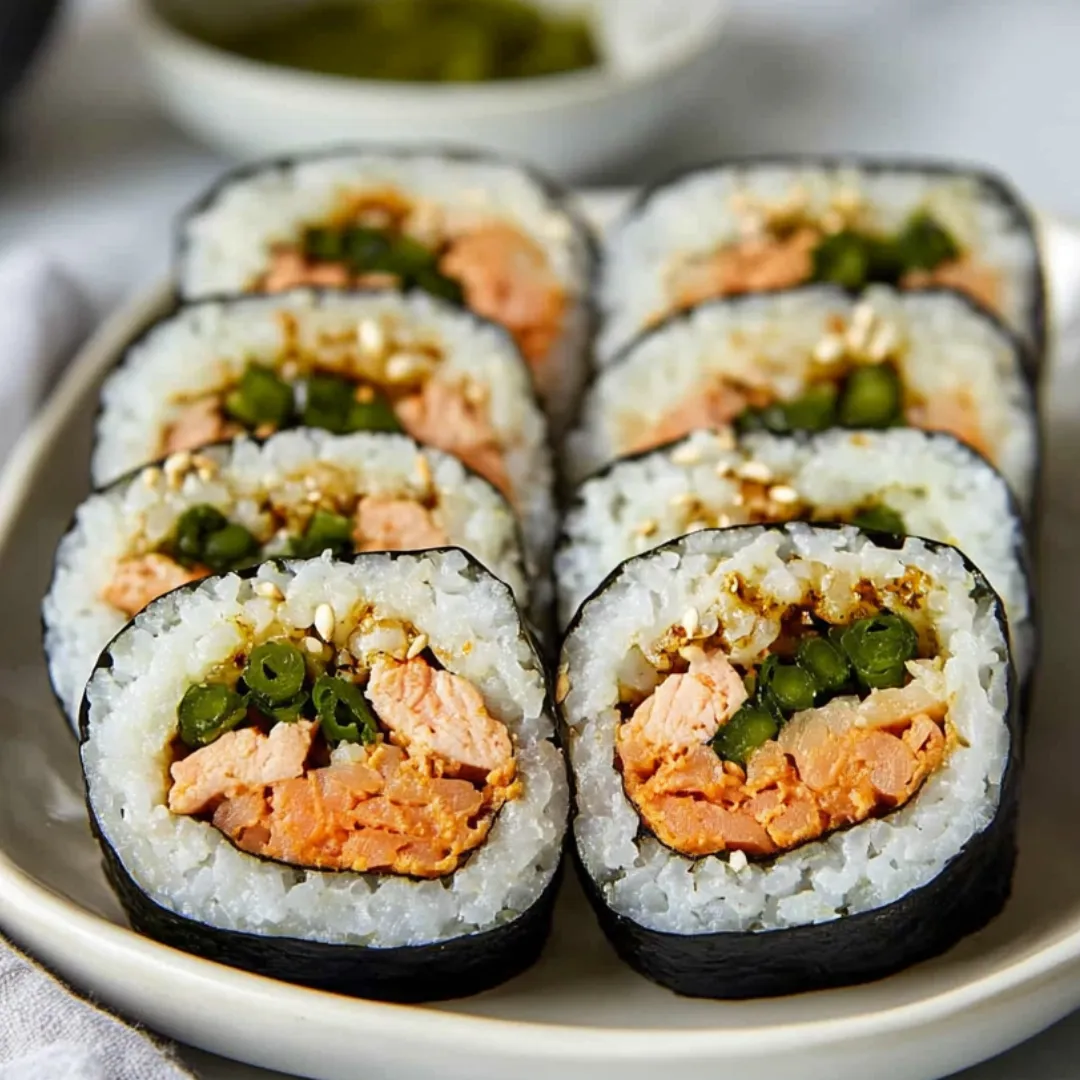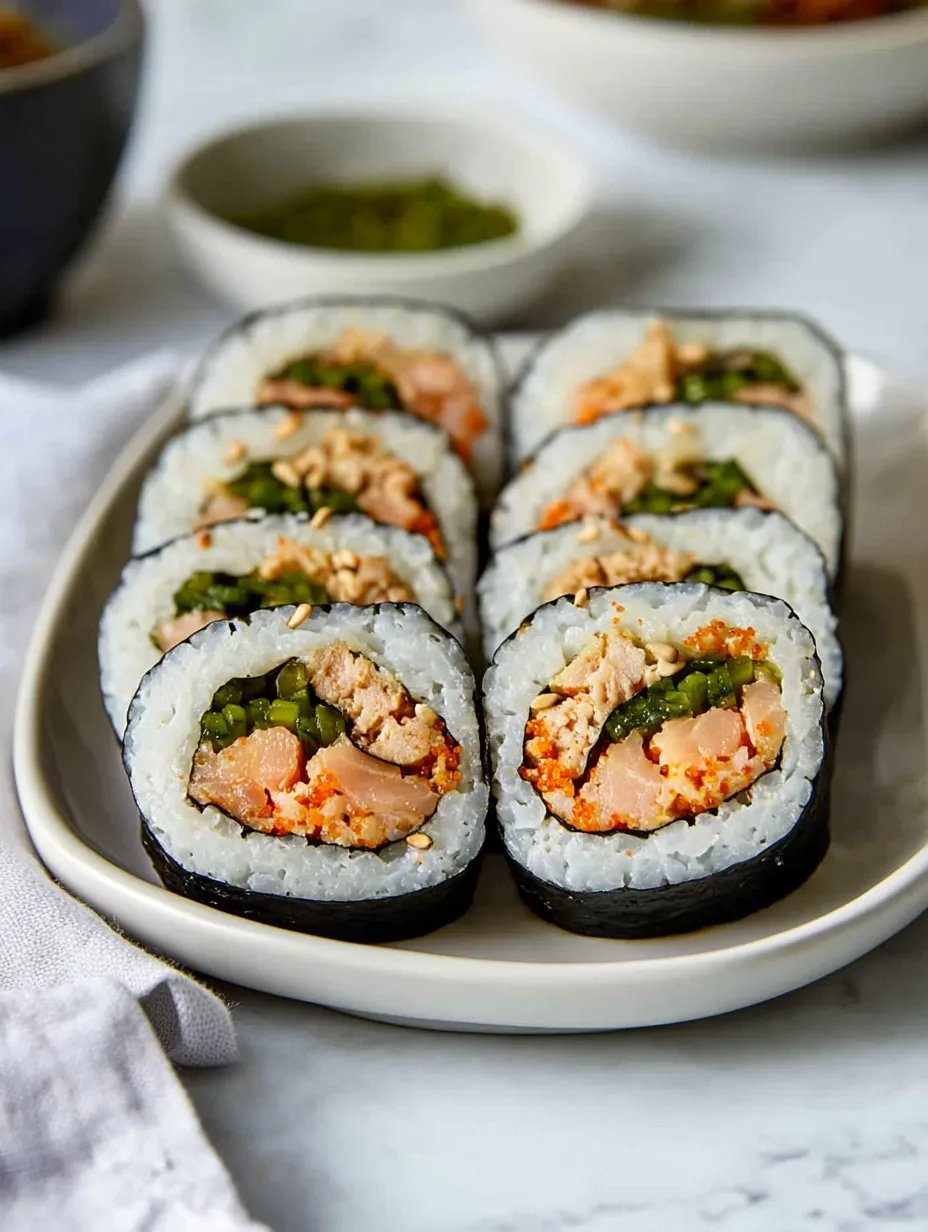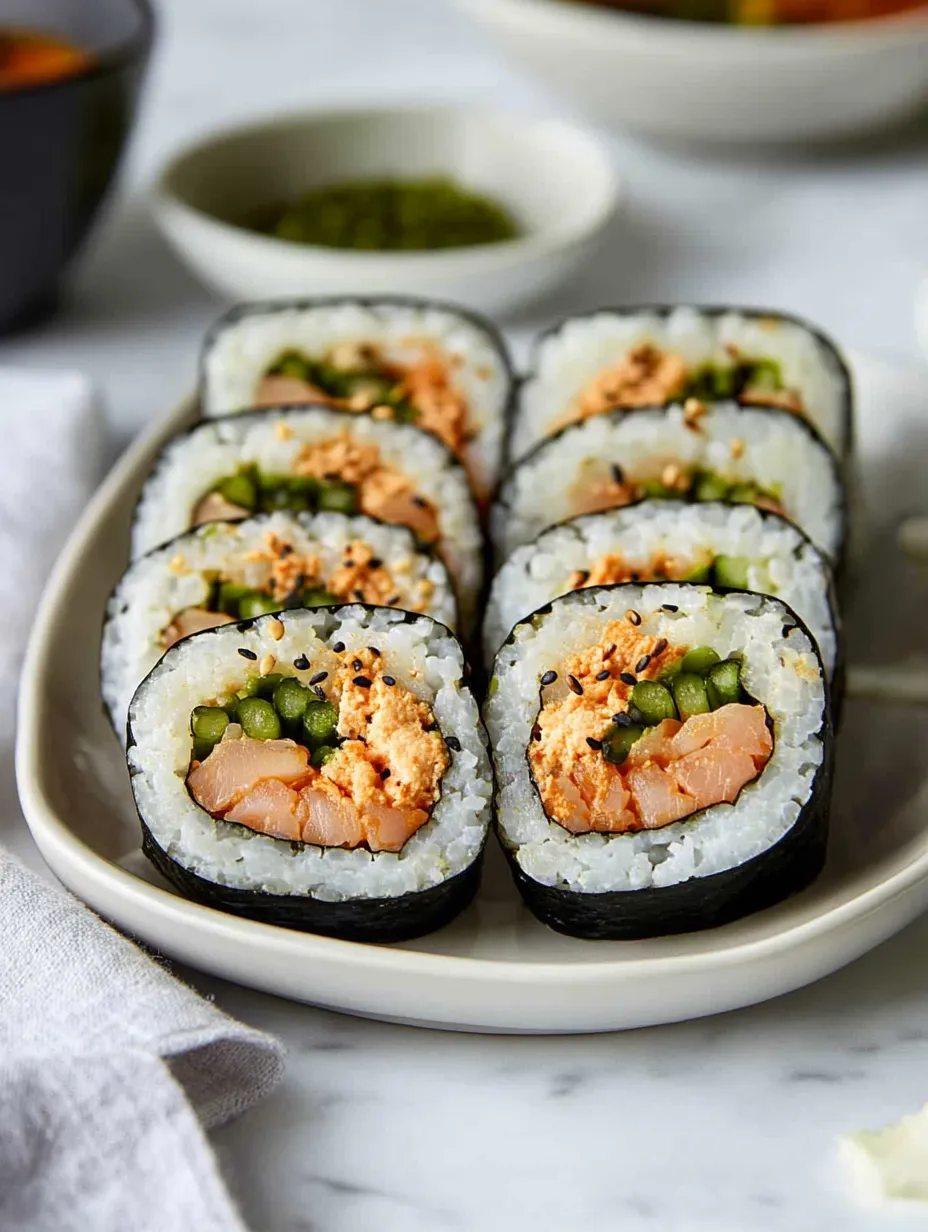 Pin it
Pin it
This hearty spicy tuna kimbap has been my go-to recipe whenever I need a quick meal that doesn't compromise on flavor. The combination of seasoned rice, umami-rich tuna, and aromatic perilla leaves creates a perfect harmony of textures and tastes that satisfies every time.
I first created this recipe during a particularly busy work week when I needed something quick but satisfying. My family was skeptical about homemade kimbap at first but now it's our favorite solution for impromptu picnics and road trips.
Ingredients
- Nori sheets: fresh packages provide the best texture and flavor for wrapping
- Perilla leaves: their minty anise flavor elevates the kimbap tremendously but lettuce works in a pinch
- Short grain rice: essential for the proper sticky texture that holds everything together
- Canned tuna: in oil provides more flavor but water packed works well for a lighter version
- Japanese mayo: Kewpie brand delivers that authentic umami richness regular mayo lacks
- Sriracha sauce: builds a customizable heat level while adding garlic notes
- Sesame oil: toasted variety brings the quintessential nutty aroma that defines Korean cuisine
- Sesame seeds: adds a pleasant crunch and visual appeal to the finished rolls
Step-by-Step Instructions
- Prepare the tuna filling:
- Thoroughly drain your canned tuna using a fine sieve and pressing with a fork to remove all excess liquid. This prevents your kimbap from becoming soggy. Combine with finely chopped green onions, Japanese mayo, and sriracha in a bowl, mixing until well incorporated but still maintaining some texture. The filling should be cohesive but not overly smooth.
- Season the rice:
- Work with hot, freshly cooked rice for best results. The warmth helps the sesame oil, sesame seeds, and salt distribute evenly throughout each grain. Cover with a damp towel after mixing to maintain moisture and stickiness, which is crucial for proper rolling.
- Set up your rolling station:
- Position your nori sheet rough side up on a clean cutting board or bamboo mat if available. The rough texture helps the rice adhere better during rolling. Ensure your hands are slightly damp to prevent rice from sticking to them when spreading.
- Spread the rice layer:
- Place one cup of seasoned rice in the center of the nori and spread outward using gentle pressing motions, leaving a one-inch border at the top edge. The rice layer should be even but not compressed too firmly, which would make the kimbap dense and chewy.
- Layer the fillings:
- Arrange perilla leaves overlapping in the center of the rice, creating a protective barrier for the spicy tuna mixture. Shape the tuna filling into a log approximately one inch in diameter centered on the perilla leaves. Resist the urge to spread it too thin or it will squeeze out during rolling.
- Execute the rolling technique:
- Begin rolling from the bottom edge closest to you, keeping firm even pressure throughout. Use your fingertips to tuck in the filling as you go, maintaining a tight cylindrical shape. Allow the roll to rest briefly on the final edge, letting the heat from the rice seal the seam naturally.
- Finish with seasoning:
- Brush the completed roll lightly with sesame oil to add flavor and give the exterior a beautiful sheen. This also prevents the nori from becoming too chewy and helps the sesame seeds adhere when sprinkled over the surface.
- Slice with precision:
- Oil your knife blade lightly before cutting to prevent sticking. Hold the roll gently but firmly and use a sawing motion to create clean slices approximately one inch thick. Wipe and re-oil the knife between cuts for the cleanest presentation.
 Pin it
Pin it
The perilla leaves are truly the secret star of this recipe. I discovered their importance while traveling through South Korea where a local grandmother insisted they were non-negotiable in authentic kimbap. Their unique flavor reminds me of a cross between mint and basil with subtle licorice notes that perfectly complement the spicy tuna.
Storage Guidelines
Freshly made kimbap is always best consumed immediately after preparation when the seaweed maintains its optimal crisp texture. However, if you need to prepare in advance, wrap each roll tightly in plastic wrap before refrigerating. This creates a barrier against moisture that would otherwise soften the seaweed. For best results, consume refrigerated kimbap within 24 hours and allow it to return to room temperature before serving for the best texture and flavor experience.
Clever Substitutions
This recipe welcomes creative adaptations based on what you have available. If perilla leaves are difficult to find, substitute with baby spinach leaves or butter lettuce for a similar protective layer. Not a fan of tuna? Try canned salmon or even cooked shredded chicken mixed with the same sauce ingredients. For a vegetarian version, replace the tuna with finely diced tofu or tempeh marinated in a mixture of soy sauce, sesame oil, and sriracha. If Japanese mayo is unavailable, regular mayonnaise combined with a small amount of rice vinegar and sugar creates a reasonable alternative.
 Pin it
Pin it
Serving Suggestions
Traditionally, kimbap is served with kimchi for a contrasting tangy crunch but there are many complementary side dishes that enhance the experience. Consider serving with a small bowl of miso soup for a complete light meal. For a beautiful appetizer presentation, arrange slices on a decorative plate with a small dish of soy sauce mixed with wasabi for dipping. When packing for picnics or travel, wrap individual pieces in parchment paper or plastic wrap for easy handheld eating. For a family-style meal, create a variety of kimbap with different fillings and arrange on a large platter for everyone to sample.
Cultural Context
Kimbap holds a special place in Korean food culture as both everyday fare and special occasion food. Unlike Japanese sushi, which often features raw fish, Korean kimbap typically contains cooked or preserved ingredients, making it safe for packed lunches and picnics. The dish gained popularity during the mid-20th century as a convenient portable meal for workers and students. The name combines "kim" meaning seaweed and "bap" meaning rice reflecting its essential components. In Korean households, kimbap making is often a family activity with each person contributing to the assembly line process, creating memories along with delicious food.
Frequently Asked Questions
- → What type of tuna should I use?
Canned tuna in oil or water works well for this recipe. Drain it thoroughly before using.
- → Can I substitute perilla leaves?
If perilla leaves are unavailable, green leaf lettuce or spinach can be good substitutes.
- → How can I adjust the spice level?
Use more or less sriracha sauce based on your spice tolerance, or substitute with gochujang for a Korean twist.
- → How do I prevent the rolls from falling apart?
Ensure the rice and tuna filling are evenly spread, and roll tightly without squeezing out the filling.
- → What's the best way to slice kimbap cleanly?
Use a sharp knife brushed with sesame oil for smooth cuts and to prevent sticking.
